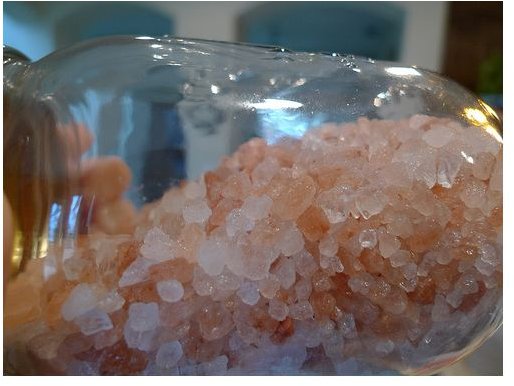Herbal Bath Salts for Better Health
Therapeutic Bath Salts
Herbal bath salts are made from dried herbs and salts. What exactly are bath salts? They are mineral salts which are absorbed into the skin, imparting their beneficial properties. Ordinary table salt, sodium chloride, is not a therapeutic bath salt. Sea salts, and in particular, dead sea salt, on the other hand, are rich in minerals, including magnesium, potassium, sodium, and calcium. They have a range of beneficial properties, helping to detoxify the body, improving immune health, balancing fluid levels, relieving pain and stiffness, and relaxing the nervous system.
Epsom salts are also beneficial healing compounds. They consist of magnesium sulfate, not sodium. Epsom salts have an intensely purifying effect on the body, encouraging the elimination of toxins through perspiration. They are traditionally used to treat mild respiratory infections, minor injuries, and aching joints and muscles. The absorbed magnesium calms the nervous system, promoting restful sleep and stress relief. Sulfates help to protect cells from the effects of radiation and pollution, and fortify the body’s ability to resist bacteria.
Bath salts are not considered a medical cure for any disease. They are however, believed to help slow the aging process, and can be useful for treating:
- Insomnia
- Arthritis
- Anxiety
- Eczema and psoriasis
- Tension and sore muscles
Beneficial Herbs
Combining the healing benefits of herbs with the therapeutic effect of bath salts creates an incredible healing experience. Different herbs can be combined to treat specific ailments, or simply to create a calming therapy for overall well-being.
- Chamomile relaxes the nervous system. It is a wonderful, delicate-smelling herb for treating insomnia, anxiety, and tension. It also has anti-inflammatory and antibacterial properties, making it useful for arthritis or minor colds.
- Lavender is ideal for relieving stress, treating depression and anxiety. It is also useful for headaches and skin conditions.
- Peppermint reduces fevers, and encourages the elimination of toxins through the skin. It is also a calming nervine herb.
- Elder flowers are very good for cold and flues. They reduce inflammation, ease congestion, and help to reduce fevers.
- Rosemary stimulates both the nervous and circulatory systems. It relieves mental tension.
- Lime blossom is good for high blood pressure, headaches, and insomnia.
- Lemon verbena relieves stress, depression, and insomnia.
- Ginger is a stimulating, warming herb, which increases blood circulation and energizes the body.
Try combining chamomile and lavender for anxiety and stress; peppermint, rosemary, and elder flower for respiratory infections; lime blossom and lemon verbena for insomnia, and ginger as an overall health tonic.
How to Make Herbal Salts
To make herbal bath salts, wrap the herbs and the salts in a thin cloth pouch, made of muslin or cheesecloth. Toss it in the bath, holding it under the running bath water, and swirling it around to help the salts dissolve and the herbs infuse. It can be left in the water for the entire bath. When finished, throw out the remaining contents. The pouch can be reused.
Should you use epsom salts or sea salts? Either is fine, or use both. For a simple recipe, combine two cups of epsom salts, with one cup of sea salt. Add one-half cup of baking soda as well, if desired. Use one and one-half cups of dried herbs. Mix together and store in a dark glass or ceramic jar. Use one cup per bath.
Herbal baths are soothing and therapeutic. Talk to a doctor however, if pregnant, on prescription medications, or if you have high blood pressure.
Resources
Bath Salt Selection Guide (Salt Works) https://www.saltworks.us/salt\_info/bath-salt-guide.asp#EpsomSalt
Homemade Herbal Bath Bag Recipes https://tipnut.com/homemade-herbal-bath-bag-recipes/
Balch, Phyllis, CNC. “Prescription for Nutritional Healing, 4th Edition.” (The Penguin Group, 2006).
Hoffmann, David. “The Complete Illustrated Holistic Herbal: A Safe and Practical Guide to Making and Using Herbal Remedies.” (Element Books, 1996).
Photo Credit
photo by: Shane Vaughn (CC/flickr) https://www.flickr.com/photos/pavati/4125644013/
Disclaimer
Please read this disclaimer regarding the information contained within this article.
